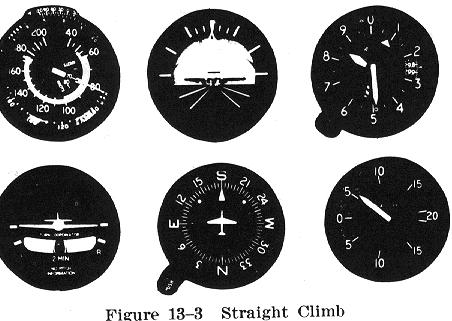
Generally, when adverse weather is encountered, a climb by reference to flight instruments is required primarily to assure clearance of obstructions or terrain. However, it may sometimes be advisable to climb to a clear area above a layer of fog, haze, or low clouds.
As in straight descents, the climb should be made at a constant airspeed - one that is well above the stall and yet results in a positive climb. The power setting and the pitch attitude determine the airspeed.
Again, the attitude indicator provides the greatest help in visualizing the pitch attitude. To enter a constant airspeed climb from cruising airspeed (the most likely entry speed), the nose of the representative airplane is raised in relation to the artificial horizon to the approximate climbing attitude (Fig. 13-3). Only a small amount of elevator back pressure should be added to initiate and maintain the climb attitude. The power setting may be advanced to climb power simultaneously with the pitch change, or, after the pitch change is established and the airspeed approaches the desired climb speed.

If no attitude indicator is available, the pilot need apply only sufficient elevator pressure to start the airspeed pointer moving toward the desired climb airspeed and to cause the altimeter to show an upward trend. Because of inertia, speed will not be reduced immediately to the climb speed. The pilot must give the airspeed time to stabilize, then should apply whatever additional elevator pressure is needed to attain and maintain the desired airspeed. During the climb, the power should remain at a fixed (constant) setting and deviation in airspeed should be corrected by making pitch changes. Making throttle adjustments to correct for airspeed is unnecessary and burdensome.
As in straight descent during the emergency use of flight instruments, maintaining a precise airspeed is not important. The primary objective is to keep the airplane climbing - and not allow a stall to occur.
While climbing, the directional instruments should be scanned to detect any lapse of directional control just as in straight and level flight and straight descents. Unless a specific heading is required, slight deviations in headings, particularly in gusty air, should be of little concern - just keep the wings as level as possible.